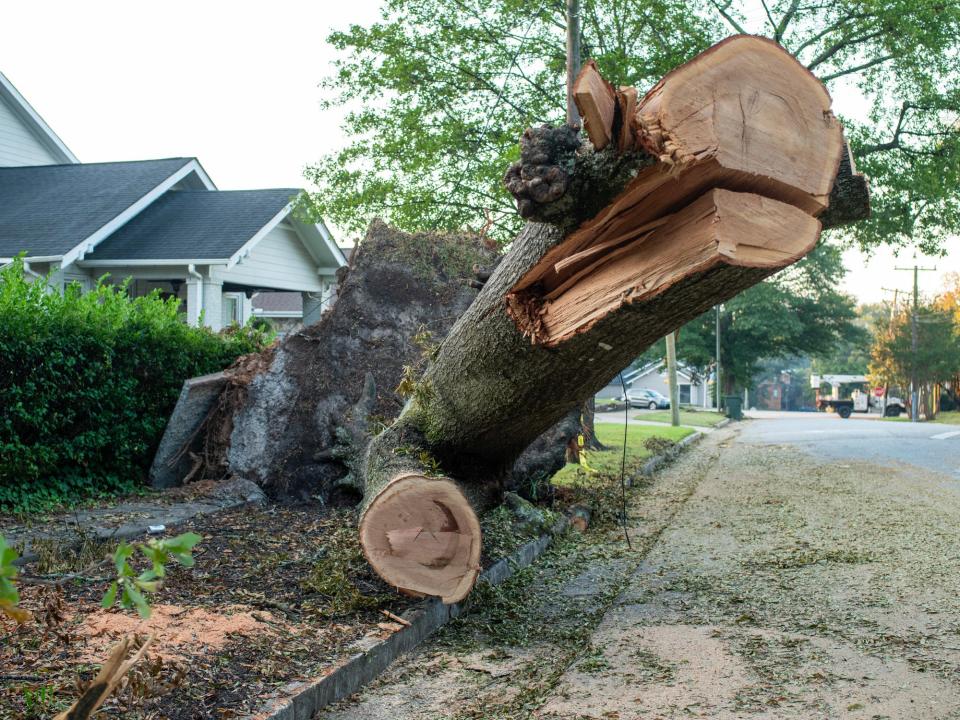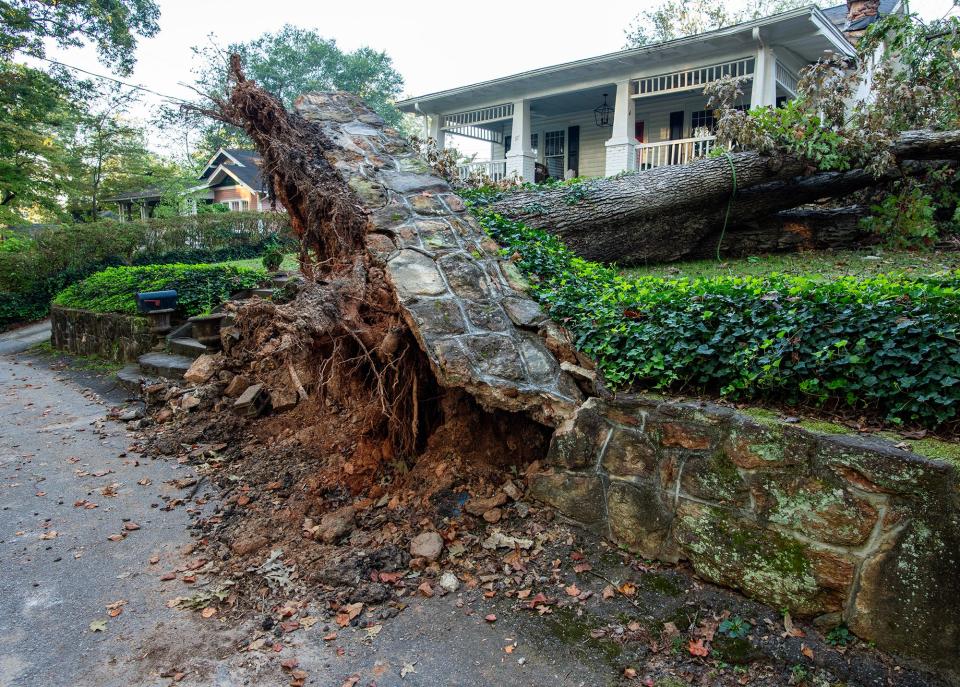It’s hard not to stare at the giant tulip poplar tree in Greenville’s Hessie T. Morrah Park, especially for Ako Matsuzaki.
It’s the tree she always admired while walking her dog Mochi. And because of that, it’s where her fiancé proposed. And where she said yes.
The gigantic tree, also home to gender reveal celebrations and people who curl up to read or paint, is a survivor.
“We thought it was such a beautiful testament, not just to our relationship, but to all the relationships that exist today, where there’s always going to be tough times, but you weather through it,” Matsuzaki said.
Her beloved park tree withstood Helene’s damage, which brought down thousands of untold trees across the Upstate.


Across the Upstate and beyond, trees often fell during the storm because of some underlying problem with the tree, said Robert Polomski, a Clemson University extension specialist in horticulture and arboriculture.
“Many of them were predisposed to some defect, and with the rains prior to Helene and during, that compromised these trees,” Polomski said.
Trees that are still standing – especially if they are near homes or cars – could be ripe for a basic half-hour homeowner inspection (he has a 7-point guide) but if anything is amiss, a professional arborist should be called in, Polomski said.
Many of the trees that fell in the city of Greenville were water oaks that were at or near the end of their under-100-year life anyway, said Joelle Teachey, formerly the long-time executive director of Trees Upstate, who was authorized to discuss the organization’s response to Helene.
The water oaks along several major Greenville streets have long been identified as potential issues, and the solution is to replant trees, she said.
Durant Ashmore, a landscape designer and horticulturalist, said the giant red-dirt-encrusted root balls, seen all across the Upstate since the storm, will often be from white oaks. The tree tends to have a saucer-shaped root ball that doesn’t go much deeper than two feet, he said.
“The primary tree that went down was white oak and white oak has always been the sturdiest tree in the forest,” he said. “They don’t go deep down like a tap root like your pines and nut trees like pecan and hickory do.”
The white oak roots themselves can go twice as wide as the tree is tall, but the root ball rarely gets very deep, he said.
Ashmore, a famed hater of the Bradford pear tree, said that the irony of the storm is that the normally sturdy white oaks fell while the normally-prone-to-breaking Bradford pears escaped the storm virtually unharmed.
“I’ve only heard of one Bradford pear falling,” Ashmore said, disappointed.
That’s because the Bradford pear’s weakness is its branches, which often fall on cars and homes, but the roots are strong, Ashmore said.
Earlier this year, Greenville County released a study that found a 38% tree canopy over the county. Plans to boost that to as high as 46% would require protecting existing trees and planting new ones.
The study pointed to tree benefits, including health, property values, protection from heat and lower energy costs. But as Greenville and the rest of the Palmetto State face rapid development, mature trees were seen to be at risk of development.
The study recommended optimizing stormwater designs and planting trees in flat areas to reforest, which could help to mitigate future storms.
Teachey said the canopy is so large in Greenville County that it is unlikely to decrease, even though there’s lots of trees on the ground. There may be a noticeable dip in the city’s canopy coverage, but likely not more than a percentage point or two, she said.
“The loss of trees in the city is tragic now and people are dealing with a lot of loss,” Teachey said. “The next step is removal, cleanup, calling up the tree workers and returning to replanting trees.”
She said donors and staff at Trees Upstate had trees fall on their homes during the storm.
Polomski worries that people will start hating trees and withdrawing from plans to boost the trees, especially since so many need to be replaced now.
Polomski said the fallen trees could pose challenges in the near future, providing fuel for potential wildfires and leading to discussions about proscribed burns or other fire control measures.


“Even forests have to be managed, we’re seeing how critical that is out West,” he said.
But the trees in Greenville will continue to be important, said John DeWorken, a Greenville council member.
He said that shortly before the storm, the city had approved a policy calling for replacing trees that were removed or fell down from public right-of-way areas. The city has also committed to planting 1,000 new trees a year, which may need to be boosted, DeWorken said.
The replacements may not measure up, at least right away, because replacing 100—and 200-year-old trees takes time, but DeWorken said he hopes the city will keep focusing on increasing the number of trees.
It’s too early to make any evaluations of the tree cover in the city of Greenville and the city’s urban forester and his team are working on tree safety, said Beth Brotherton, a spokesperson for the city, in an email.
“We know our tree canopy took a significant hit, but we are still assessing,” she said.


But it’s never too early to appreciate the trees, Matsuzaki said.
She previously lived in big cities like San Francisco and moved to Greenville about three years ago.
That towering tulip poplar tree she adores?
It’s a wonderful specimen, Polomski said, and was used traditionally by Native Americans to make canoes because it was so straight and large.
Walking among the devastation of the trees in the park near her home on Monday morning, Matsuzaki said she is seeing the best of Greenville after the storm.
“People are supporting each other, communities are coming out, people are checking in on neighbors. That part is beautiful,” she said, patting Mochi. “At the end of the day, it’s the little things that matter. We go on our daily walk and pass this big tree so many times, it’s a good memory for us. It’s here and it’s strong and it’s been there for us and hopefully we can be there for it.”
Contact Mike Ellis at mellis@gannett.com or 517-267-0415
This article originally appeared on Greenville News: Greenville’s tree canopy smashed by Helene; will they be replaced?
